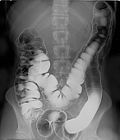Radiocontrast agent
Radiocontrast agent is a type of medical imaging agent used to improve the visibility of internal structures in X-ray based imaging techniques such as computed tomography (CT) or radiography.
Overview[edit]
Radiocontrast agents are substances that are used in radiology to enhance the visibility of certain structures or fluids within the body. These agents work by altering the way that X-ray or other forms of radiation are absorbed by the body, making it easier for the radiologist to distinguish between different types of tissue.
Types of Radiocontrast Agents[edit]
There are two main types of radiocontrast agents: Iodinated contrast and Barium sulfate.
Iodinated Contrast[edit]
Iodinated contrast is a type of radiocontrast agent that contains iodine. Iodine is a heavy element that absorbs X-rays very well and is used in a form that is relatively safe to inject into the body. Iodinated contrast agents can be used in a variety of imaging studies, including CT scans, angiography, and venography.
Barium Sulfate[edit]
Barium sulfate is another type of radiocontrast agent. It is a heavy metal salt that is not absorbed by the body and is therefore used to outline the gastrointestinal tract in X-ray imaging.
Side Effects[edit]
While radiocontrast agents are generally safe, they can cause side effects in some people. These can range from mild reactions like nausea and vomiting, to more serious reactions like anaphylaxis. In rare cases, radiocontrast agents can also cause kidney damage, especially in patients with pre-existing kidney disease.
See Also[edit]
Ad. Transform your life with W8MD's Budget GLP-1 injections from $75


W8MD offers a medical weight loss program to lose weight in Philadelphia. Our physician-supervised medical weight loss provides:
- Weight loss injections in NYC (generic and brand names):
- Zepbound / Mounjaro, Wegovy / Ozempic, Saxenda
- Most insurances accepted or discounted self-pay rates. We will obtain insurance prior authorizations if needed.
- Generic GLP1 weight loss injections from $75 for the starting dose.
- Also offer prescription weight loss medications including Phentermine, Qsymia, Diethylpropion, Contrave etc.
NYC weight loss doctor appointmentsNYC weight loss doctor appointments
Start your NYC weight loss journey today at our NYC medical weight loss and Philadelphia medical weight loss clinics.
- Call 718-946-5500 to lose weight in NYC or for medical weight loss in Philadelphia 215-676-2334.
- Tags:NYC medical weight loss, Philadelphia lose weight Zepbound NYC, Budget GLP1 weight loss injections, Wegovy Philadelphia, Wegovy NYC, Philadelphia medical weight loss, Brookly weight loss and Wegovy NYC
|
WikiMD's Wellness Encyclopedia |
| Let Food Be Thy Medicine Medicine Thy Food - Hippocrates |
Medical Disclaimer: WikiMD is not a substitute for professional medical advice. The information on WikiMD is provided as an information resource only, may be incorrect, outdated or misleading, and is not to be used or relied on for any diagnostic or treatment purposes. Please consult your health care provider before making any healthcare decisions or for guidance about a specific medical condition. WikiMD expressly disclaims responsibility, and shall have no liability, for any damages, loss, injury, or liability whatsoever suffered as a result of your reliance on the information contained in this site. By visiting this site you agree to the foregoing terms and conditions, which may from time to time be changed or supplemented by WikiMD. If you do not agree to the foregoing terms and conditions, you should not enter or use this site. See full disclaimer.
Credits:Most images are courtesy of Wikimedia commons, and templates, categories Wikipedia, licensed under CC BY SA or similar.
Translate this page: - East Asian
中文,
日本,
한국어,
South Asian
हिन्दी,
தமிழ்,
తెలుగు,
Urdu,
ಕನ್ನಡ,
Southeast Asian
Indonesian,
Vietnamese,
Thai,
မြန်မာဘာသာ,
বাংলা
European
español,
Deutsch,
français,
Greek,
português do Brasil,
polski,
română,
русский,
Nederlands,
norsk,
svenska,
suomi,
Italian
Middle Eastern & African
عربى,
Turkish,
Persian,
Hebrew,
Afrikaans,
isiZulu,
Kiswahili,
Other
Bulgarian,
Hungarian,
Czech,
Swedish,
മലയാളം,
मराठी,
ਪੰਜਾਬੀ,
ગુજરાતી,
Portuguese,
Ukrainian




